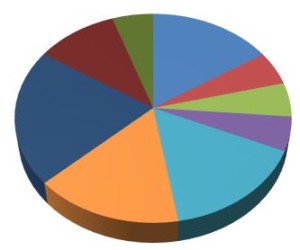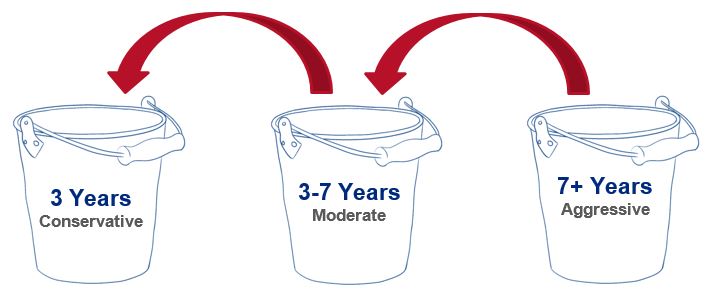Archives
What Do I Do Now? Part 2
Last Updated: September 22, 2015
What Do I Do Now? Six Ways to Deal with Market Losses in Retirement, Part Two
In Part One, we acknowledged the fear many retirees face when the market takes alarming dives, seriously depleting funds on which they depend for income, and we identified three things not to do during a market downturn. In this article, we will cover the three things to do after the market has recovered and before the next decline hits your account.What to do after the market recovers
1) Allocate appropriately. If the roller coaster ride during the downturn was too stressful for you, then talk with your financial planner about reallocating your portfolio so it’s more conservative. By adjusting the mix of funds in your accounts so they better match your risk tolerance, you are less likely to panic the next time the market drops. Before you implement your new allocation, ask a Certified Financial Planner™ professional to back-test it for you. See how that mix of asset classes would have performed over the last 20 years and take particular note of how far it drops during times of market instability. Past performance is no guarantee of future results, but if it would have dropped further than you’re comfortable with in the past, you’ll probably want to readjust your allocation so it’s more conservative in the future.
2. Maintain conservative withdrawal assumptions. Don’t assume that because your account averages 6% return, you can safely withdraw 6% for income. That’s because, when people are generating income from their portfolio, it’s not just the average return that matters; it’s the sequence of those returns.
The chart entitled “Sequence of Returns Comparison” demonstrates what I mean. It shows a $1 million portfolio from which $50,000 a year is being withdrawn for income (indexed for inflation). In the green columns, we see how that portfolio would have been affected by the actual returns of the stock market for the 20-year period of 1989-2008.
Before you implement your new allocation, ask a Certified Financial Planner™ professional to back-test it for you. See how that mix of asset classes would have performed over the last 20 years and take particular note of how far it drops during times of market instability. Past performance is no guarantee of future results, but if it would have dropped further than you’re comfortable with in the past, you’ll probably want to readjust your allocation so it’s more conservative in the future.
2. Maintain conservative withdrawal assumptions. Don’t assume that because your account averages 6% return, you can safely withdraw 6% for income. That’s because, when people are generating income from their portfolio, it’s not just the average return that matters; it’s the sequence of those returns.
The chart entitled “Sequence of Returns Comparison” demonstrates what I mean. It shows a $1 million portfolio from which $50,000 a year is being withdrawn for income (indexed for inflation). In the green columns, we see how that portfolio would have been affected by the actual returns of the stock market for the 20-year period of 1989-2008.
 The orange columns show how that same portfolio would have performed if the sequence of those returns had been reversed. The average return over that time period is exactly the same in each section, but one portfolio has grown to over $3 million, and the other has dwindled to nothing. The only difference is the order of returns – one portfolio ends with a really bad year in the market and the other begins there1.
Ask a Certified Financial Planner™ professional to run a Monte Carlo Analysis for you to help you determine what you consider a safe withdrawal rate based on your mix of investments, your risk tolerance and your life situation. Instead of just using an average return, that analysis will take into account many possible sequences of returns to help you see your likelihood of success at generating various levels of income.
3) Implement a bucket strategy for your retirement income needs. If you want your money to last through retirement, it’s important to keep it growing – which generally means taking some risk. But at the same time, you need to protect your money so it can provide you with the income you need now, whether the market is up or down – which means reducing the risk. How can you accomplish both goals?
The orange columns show how that same portfolio would have performed if the sequence of those returns had been reversed. The average return over that time period is exactly the same in each section, but one portfolio has grown to over $3 million, and the other has dwindled to nothing. The only difference is the order of returns – one portfolio ends with a really bad year in the market and the other begins there1.
Ask a Certified Financial Planner™ professional to run a Monte Carlo Analysis for you to help you determine what you consider a safe withdrawal rate based on your mix of investments, your risk tolerance and your life situation. Instead of just using an average return, that analysis will take into account many possible sequences of returns to help you see your likelihood of success at generating various levels of income.
3) Implement a bucket strategy for your retirement income needs. If you want your money to last through retirement, it’s important to keep it growing – which generally means taking some risk. But at the same time, you need to protect your money so it can provide you with the income you need now, whether the market is up or down – which means reducing the risk. How can you accomplish both goals?
 Work with your financial planner to set up three buckets for your investments. The first bucket is for your current income needs – maybe three years’ worth. That money will be invested very conservatively – in cash equivalents or short-term bonds. That way, if the market goes down, you don’t have to worry about having enough income. You have three years’ worth that’s not affected by market conditions.
Then set up a second bucket with enough money for another four years or more of income. This money can be invested more moderately – maybe in a mix of longer term bonds and some dividend-paying stocks. That way the money has the potential to grow, but with less risk of significant losses during down times.
The third bucket is for money you won’t need for seven years or more. It can be invested as aggressively as your risk tolerance can handle, because it will have at least seven years to recover if the market takes a dive.
Typically, the moderate bucket will fill faster than the conservative one, and the aggressive one will fill faster than the moderate. As this happens, refill the other buckets with the earnings so that you’ll always have safe money from which to draw your income. Work closely with your adviser on the timing of these refills so you’re not cashing out while the market’s down.
For help protecting your nest egg and generating the income you need in retirement, contact the Certified Financial Planner™ professionals at Pension Consultants by calling 800-234-9584. Your choice is your future.
Work with your financial planner to set up three buckets for your investments. The first bucket is for your current income needs – maybe three years’ worth. That money will be invested very conservatively – in cash equivalents or short-term bonds. That way, if the market goes down, you don’t have to worry about having enough income. You have three years’ worth that’s not affected by market conditions.
Then set up a second bucket with enough money for another four years or more of income. This money can be invested more moderately – maybe in a mix of longer term bonds and some dividend-paying stocks. That way the money has the potential to grow, but with less risk of significant losses during down times.
The third bucket is for money you won’t need for seven years or more. It can be invested as aggressively as your risk tolerance can handle, because it will have at least seven years to recover if the market takes a dive.
Typically, the moderate bucket will fill faster than the conservative one, and the aggressive one will fill faster than the moderate. As this happens, refill the other buckets with the earnings so that you’ll always have safe money from which to draw your income. Work closely with your adviser on the timing of these refills so you’re not cashing out while the market’s down.
For help protecting your nest egg and generating the income you need in retirement, contact the Certified Financial Planner™ professionals at Pension Consultants by calling 800-234-9584. Your choice is your future.



